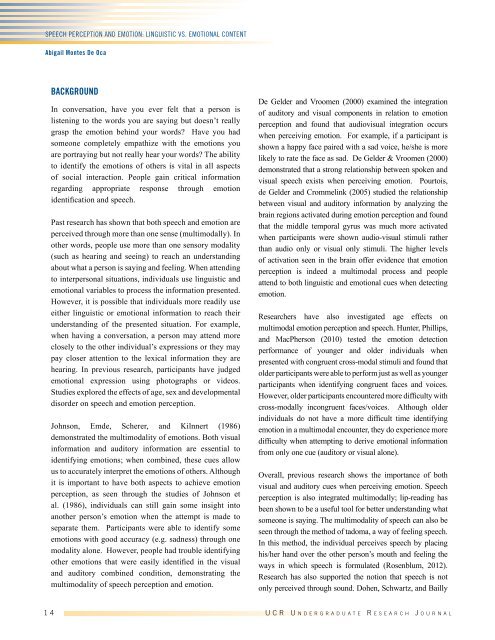Undergraduate Research Journal
Undergraduate Research Journal
Undergraduate Research Journal
You also want an ePaper? Increase the reach of your titles
YUMPU automatically turns print PDFs into web optimized ePapers that Google loves.
Speech Perception and Emotion: Linguistic vs. Emotional Content<br />
Abigail Montes De Oca<br />
BACKGROUND<br />
In conversation, have you ever felt that a person is<br />
listening to the words you are saying but doesn’t really<br />
grasp the emotion behind your words? Have you had<br />
someone completely empathize with the emotions you<br />
are portraying but not really hear your words? The ability<br />
to identify the emotions of others is vital in all aspects<br />
of social interaction. People gain critical information<br />
regarding appropriate response through emotion<br />
identification and speech.<br />
Past research has shown that both speech and emotion are<br />
perceived through more than one sense (multimodally). In<br />
other words, people use more than one sensory modality<br />
(such as hearing and seeing) to reach an understanding<br />
about what a person is saying and feeling. When attending<br />
to interpersonal situations, individuals use linguistic and<br />
emotional variables to process the information presented.<br />
However, it is possible that individuals more readily use<br />
either linguistic or emotional information to reach their<br />
understanding of the presented situation. For example,<br />
when having a conversation, a person may attend more<br />
closely to the other individual’s expressions or they may<br />
pay closer attention to the lexical information they are<br />
hearing. In previous research, participants have judged<br />
emotional expression using photographs or videos.<br />
Studies explored the effects of age, sex and developmental<br />
disorder on speech and emotion perception.<br />
Johnson, Emde, Scherer, and Kilnnert (1986)<br />
demonstrated the multimodality of emotions. Both visual<br />
information and auditory information are essential to<br />
identifying emotions; when combined, these cues allow<br />
us to accurately interpret the emotions of others. Although<br />
it is important to have both aspects to achieve emotion<br />
perception, as seen through the studies of Johnson et<br />
al. (1986), individuals can still gain some insight into<br />
another person’s emotion when the attempt is made to<br />
separate them. Participants were able to identify some<br />
emotions with good accuracy (e.g. sadness) through one<br />
modality alone. However, people had trouble identifying<br />
other emotions that were easily identified in the visual<br />
and auditory combined condition, demonstrating the<br />
multimodality of speech perception and emotion.<br />
De Gelder and Vroomen (2000) examined the integration<br />
of auditory and visual components in relation to emotion<br />
perception and found that audiovisual integration occurs<br />
when perceiving emotion. For example, if a participant is<br />
shown a happy face paired with a sad voice, he/she is more<br />
likely to rate the face as sad. De Gelder & Vroomen (2000)<br />
demonstrated that a strong relationship between spoken and<br />
visual speech exists when perceiving emotion. Pourtois,<br />
de Gelder and Crommelink (2005) studied the relationship<br />
between visual and auditory information by analyzing the<br />
brain regions activated during emotion perception and found<br />
that the middle temporal gyrus was much more activated<br />
when participants were shown audio-visual stimuli rather<br />
than audio only or visual only stimuli. The higher levels<br />
of activation seen in the brain offer evidence that emotion<br />
perception is indeed a multimodal process and people<br />
attend to both linguistic and emotional cues when detecting<br />
emotion.<br />
<strong>Research</strong>ers have also investigated age effects on<br />
multimodal emotion perception and speech. Hunter, Phillips,<br />
and MacPherson (2010) tested the emotion detection<br />
performance of younger and older individuals when<br />
presented with congruent cross-modal stimuli and found that<br />
older participants were able to perform just as well as younger<br />
participants when identifying congruent faces and voices.<br />
However, older participants encountered more difficulty with<br />
cross-modally incongruent faces/voices. Although older<br />
individuals do not have a more difficult time identifying<br />
emotion in a multimodal encounter, they do experience more<br />
difficulty when attempting to derive emotional information<br />
from only one cue (auditory or visual alone).<br />
Overall, previous research shows the importance of both<br />
visual and auditory cues when perceiving emotion. Speech<br />
perception is also integrated multimodally; lip-reading has<br />
been shown to be a useful tool for better understanding what<br />
someone is saying. The multimodality of speech can also be<br />
seen through the method of tadoma, a way of feeling speech.<br />
In this method, the individual perceives speech by placing<br />
his/her hand over the other person’s mouth and feeling the<br />
ways in which speech is formulated (Rosenblum, 2012).<br />
<strong>Research</strong> has also supported the notion that speech is not<br />
only perceived through sound. Dohen, Schwartz, and Bailly<br />
1 4 U C R U n d e r g r a d u a t e R e s e a r c h J o u r n a l














